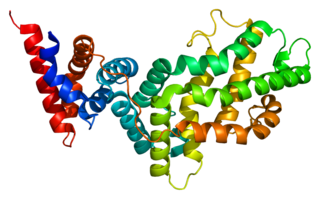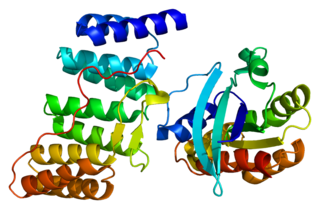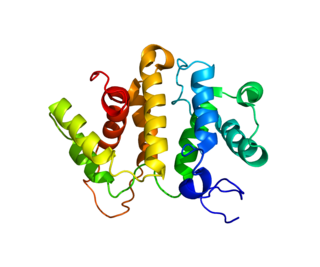
FYVE, RhoGEF and PH domain-containing protein 1 (FGD1) also known as faciogenital dysplasia 1 protein (FGDY), zinc finger FYVE domain-containing protein 3 (ZFYVE3), or Rho/Rac guanine nucleotide exchange factor FGD1 is a protein that in humans is encoded by the FGD1 gene that lies on the X chromosome. Orthologs of the FGD1 gene are found in dog, cow, mouse, rat, and zebrafish, and also budding yeast and C. elegans. It is a member of the FYVE, RhoGEF and PH domain containing family.

Rac1, also known as Ras-related C3 botulinum toxin substrate 1, is a protein found in human cells. It is encoded by the RAC1 gene. This gene can produce a variety of alternatively spliced versions of the Rac1 protein, which appear to carry out different functions.

Transforming protein RhoA, also known as Ras homolog family member A (RhoA), is a small GTPase protein in the Rho family of GTPases that in humans is encoded by the RHOA gene. While the effects of RhoA activity are not all well known, it is primarily associated with cytoskeleton regulation, mostly actin stress fibers formation and actomyosin contractility. It acts upon several effectors. Among them, ROCK1 and DIAPH1 are the best described. RhoA, and the other Rho GTPases, are part of a larger family of related proteins known as the Ras superfamily, a family of proteins involved in the regulation and timing of cell division. RhoA is one of the oldest Rho GTPases, with homologues present in the genomes since 1.5 billion years. As a consequence, RhoA is somehow involved in many cellular processes which emerged throughout evolution. RhoA specifically is regarded as a prominent regulatory factor in other functions such as the regulation of cytoskeletal dynamics, transcription, cell cycle progression and cell transformation.

ROCK1 is a protein serine/threonine kinase also known as rho-associated, coiled-coil-containing protein kinase 1. Other common names are ROKβ and P160ROCK. ROCK1 is a major downstream effector of the small GTPase RhoA and is a regulator of the actomyosin cytoskeleton which promotes contractile force generation. ROCK1 plays a role in cancer and in particular cell motility, metastasis, and angiogenesis.

RAS p21 protein activator 1 or RasGAP, also known as RASA1, is a 120-kDa cytosolic human protein that provides two principal activities:

Rac GTPase-activating protein 1 is an enzyme that in humans is encoded by the RACGAP1 gene.

Ras-related C3 botulinum toxin substrate 3 (Rac3) is a G protein that in humans is encoded by the RAC3 gene. It is an important component of intracellular signalling pathways. Rac3 is a member of the Rac subfamily of the Rho family of small G proteins. Members of this superfamily appear to regulate a diverse array of cellular events, including the control of cell growth, cytoskeletal reorganization, and the activation of protein kinases.

RhoC is a small signaling G protein, and is a member of the Rac subfamily of the family Rho family of GTPases. It is encoded by the gene RHOC.

Rho guanine nucleotide exchange factor 6 is a protein that, in humans, is encoded by the ARHGEF6 gene.

Deleted in Liver Cancer 1 also known as DLC1 and StAR-related lipid transfer protein 12 (STARD12) is a protein which in humans is encoded by the DLC1 gene.

Rho GTPase-activating protein 5 is an enzyme that in humans is encoded by the ARHGAP5 gene.

RhoD is a small signaling G protein, and is a member of the Rac subfamily of the family Rho family of GTPases. It is encoded by the gene RHOD.

Oligophrenin-1 is a protein that in humans is encoded by the OPHN1 gene.

Rnd2 is a small signaling G protein, and is a member of the Rnd subgroup of the Rho family of GTPases. It is encoded by the gene RND2.

Carbohydrate-responsive element-binding protein (ChREBP) also known as MLX-interacting protein-like (MLXIPL) is a protein that in humans is encoded by the MLXIPL gene. The protein name derives from the protein's interaction with carbohydrate response element sequences of DNA.

1-acylglycerol-3-phosphate O-acyltransferase ABHD5, also known as comparative gene identification-58 (CGI-58), is an enzyme that in humans is encoded by the ABHD5 gene.

StAR-related lipid transfer domain protein 13 (STARD13) also known as deleted in liver cancer 2 protein (DLC-2) is a protein that in humans is encoded by the STARD13 gene and a member of the DLC family of proteins.

The Rho GTPase activating protein 31 is encoded in humans by the ARHGAP31 gene. It is a Cdc42/Rac1 GTPase regulator.
Rho GTPase activating protein 18 is a protein that in humans is encoded by the ARHGAP18 gene. The gene is also known as MacGAP and bA307O14.2. ARHGAP18 belongs to a family of Rho GTPase-activating proteins that modulate cell signaling.

Rho GTPase activating protein 21 is a protein that in humans is encoded by the ARHGAP21 gene.




















